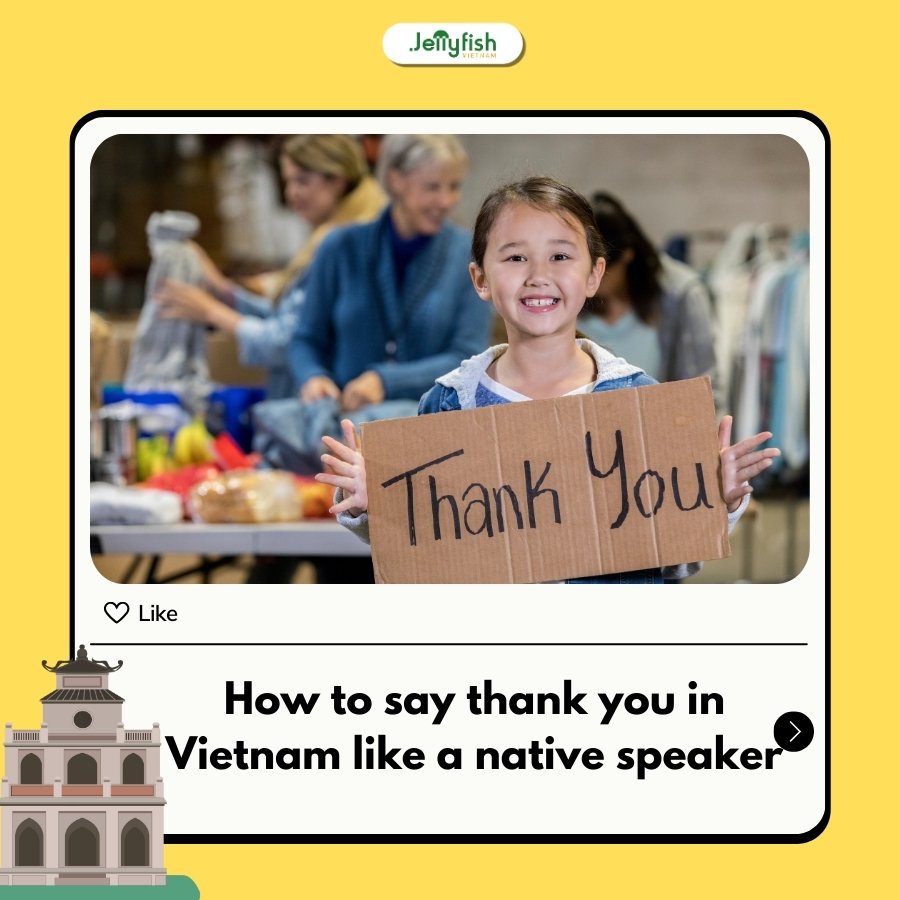Learning how to say thank you in Vietnamese is one of the first steps to mastering any language. In Vietnam, expressing gratitude is not only about words, it also reflects cultural respect and connection. Whether you’re traveling, working, or just chatting with locals, knowing the right way to say thank you will help you build meaningful relationships. In this guide, Jellyfish shows you exactly how to say thank you in Vietnamese, from simple phrases to polite expressions and real-life usage tips.
1. The most common way how to say thank you in Vietnamese
Cảm ơn
This is the most basic and widely used way to say “thank you” in Vietnamese. It literally means “to feel gratitude.”
You can use it alone or add personal pronouns for formality.
Examples:
- Cảm ơn! → Thank you! (casual, general)
- Cảm ơn bạn! → Thank you, friend! (polite, friendly)
- Cảm ơn anh/chị! → Thank you, sir/miss! (respectful)
- Cảm ơn em! → Thank you, younger person! (used with students, children, or juniors)
Cultural tip: Using the correct pronoun shows respect for age and social position, which is highly important in Vietnamese communication.
2. Polite and formal ways to say thank you
If you want to express deeper gratitude or speak in a more formal setting (like business or official contexts), try these:
- Xin cảm ơn. → “I respectfully thank you.” (Very polite and formal.)
- Chân thành cảm ơn. → “Sincerely thank you.” (Used in writing or formal speeches.)
- Rất cảm ơn. → “Thank you very much.” (Adds more emphasis.)
- Xin chân thành cảm ơn quý vị. → “We sincerely thank you all.” (Used in events or announcements.)
3. Casual ways to say thanks among friends
In daily life or casual conversations, Vietnamese also use shorter and friendly expressions like:
- Cảm ơn nhiều nha! → Thanks a lot!
- Cảm ơn nhé! → Thanks (friendly and soft tone)
- Cảm ơn em/anh nhiều! → Thank you so much, sweetly said
These are often used in texts, friendly chats, or with service people when showing kindness without being too formal.

4. Responding to “thank you” in Vietnamese
Knowing how to say thank you in Vietnamese also includes knowing how to respond politely.
Here are common replies to “Cảm ơn”:
- Không có gì. → It’s nothing / Don’t mention it.
- Không sao đâu. → No problem / It’s okay.
- Rất hân hạnh. → My pleasure. (More formal)
- Đừng khách sáo. → No need to be so formal. (Friendly and casual)
5. Real-life situations and examples
In shops or restaurants:
- When staff brings your order: Cảm ơn anh/chị!
- After paying: Cảm ơn nhé! (with a smile)
When receiving help or directions:
- Cảm ơn nhiều ạ! → Thank you very much, sir/ma’am. (adds “ạ” for respect)
At formal events or speeches:
- Xin chân thành cảm ơn sự có mặt của quý vị.
→ We sincerely thank you for your presence.
6. Cultural notes when say thank you in Vietnam
- Tone matters: A warm tone and smile are just as important as the words themselves.
- Age matters: Always adjust your pronouns to match the other person’s age or role.
- Sometimes, actions speak louder: In some rural or family settings, a thank you may be shown through gifts or helpful actions instead of just words.
- Vietnamese don’t overuse “thank you” like in Western cultures. Use it when needed, but don’t force it in every sentence.
7. Practice
Part 1: Fill in the blank
Fill in the blank with the correct Vietnamese “thank you” phrase.
- You want to thank a teacher in a polite way: “_______ cô!”
- A friend helps you carry your bag: “_______ nhé!”
- You’re making a speech in front of many people: “_______ quý vị đã lắng nghe.”
- You receive a gift from someone: “_______ nhiều!”
Part 2: Choose the best response
Choose the best Vietnamese way to say “thank you” in each situation.
- A waiter brings your coffee.
a. Cảm ơn em
b. Xin lỗi
c. Tạm biệt - Your friend gives you a ride.
a. Cảm ơn cô
b. Cảm ơn nhé
c. Xin chào - You receive help from an older man.
a. Cảm ơn chú
b. Cảm ơn em
c. Cảm ơn bạn
Conclusion
Whether you’re speaking to a friend, a teacher, or a local vendor, knowing how to say thank you in Vietnam will help you connect more meaningfully. Just remember to choose the right tone and form of speech based on age, formality, and relationship and you’ll sound natural and polite in no time.
Learn Real-Life Vietnamese with Jellyfish
At Jellyfish, we go beyond grammar and help you:
- Use everyday expressions with confidence
- Learn polite vs. casual Vietnamese in real situations
- Practice conversations with native teachers
For more information and free consultancy, please fill the form below! We will reach out to you!
👉👉 Learning Vietnamese – Jellyfish Vietnam
✦ Hotline: 096 110 6466
✦ Head office: 1st Floor, Web3 Tower Building, Alley 4 Duy Tan Street, Cau Giay District, Hanoi
✦ Branch office: 2nd floor SH5.11 Vinhomes Marina, Vinh Niem, Le Chan, Hai Phong
✦ Head office in Japan: 4F Westhill Building, Nishigotanda 2-24-4, Shinagawa, Tokyo, Japan


